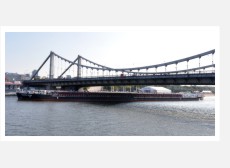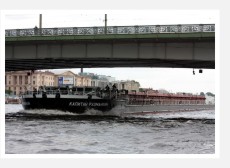 15.07.14 14:07 15.07.14 14:07
Ten RSD44 dry cargo vessels of Volga Shipping Company transported 34% more cargo this year than during 6 months of preceding year
  
According to the press-service of the Volga Shipping Company, ten RSD44 dry cargo vessels of "Volga-Don Max" class transport sulfur and grain in the first half-year at South basin. Due to the early starting of navigation, these vessels transported 228 thousand tons of cargo that is 34% more than during 6 months of last year.
All ten vessels were built for the Volga Shipping Company (Alexander Shishkin is a director) in the record terms by Oka Shipyard (Vladimir Kulikov is a director). The keel of the first vessel "Kapitan Ruzmankin" was laid down in February, 2010. Ninth and tenth vessels were put into operation in April, 2012.
In whole, capacity of cargo transportation by cargo vessels and tugboats of Volga Shipping Company during January-June of 2014 was 2.315 million tons that is by 5% more than the rate of the same period of preceding year. It is noticed that the main part of cargo transportation has shifted to South basin in the direction of Astrakhan and Caucasus ports due to transportations of export cargoes as sulfur, steel, grain and fertilizer. Capacity of sulfur transportations was 539 thousand tons; of metal was 529 thousand tons. Significant redistribution of transportation's structure for the described period is caused by increasing of export cargoes part up to 60%.
For the analogous period of the preceding year the ratio of domestic and export cargoes was 58% and 42% correspondingly.
The series can be named as "Stalingrad Heroes" series because all ten captains whose names were used for RSD44 vessels put their lives defending Motherland during battles for Stalingrad.
It should be noted that the vessel has the maximal (among all vessels of such type) deadweight in river (5540 tons while the draught is of 3.6m according to inclining test) and the maximal trial speed (average speed with and up the stream was more than 12 knots).
Vessel's project (RSD44) is designed by the Marine Engineering Bureau.
Russian River Register class notation of the project is of  M-PR 2,5 (Ice 20) A. M-PR 2,5 (Ice 20) A.
RSD44 prj. new dry-cargo vessels of "Volga-Max" class (waterline length is of 138.9 m, breadth is of 16.5 m, depth is of 5 m, coamings height is of 2.20 m) are assigned for transportation of general, bulk, timber and saw timber, grain, coal, sulfur, paper, building materials, metal production, potash and mineral fertilizer, large-sized cargoes, and also up to 140 containers through internal water ways of Russian Federation.
Deadweight in river is about 5443 t with draught of 3.6 m, deadweight at sea is about 5562 t with draught of 3.53 m. Cargo hold capacity is of 7090 cub.m.
Operation of vessels is also provided through Volga-Don Shipping Canal (VDSC), Volga-Balt Canal, Sea of Azov up to port of the Caucasus and in Gulf of Finland. Passage under Neva bridges in Saint-Petersburg region and under Rostov Railway bridge (Rostov-on-Don city) is supposed to be done without bridges drawing (maximal permissible air draught is of 5.4m for bridges' passing).
RSD44 prj. vessels' dimensions (overall length of 139.99 m, overall breadth of 16.8 m) allow to provide operations through VDSC, including "old" branch of Kochetovsk lock without "special steering" procedures.
Double bottom and double sides which cover all length of "box-shaped" cargo holds (holds' sizes: hold N1 37.8 m x 13.2 m x 6.22 m, hold N2 49.8 m x 13.2 m x 6.22 m) and fuel oil, lubricating oil and drain tanks allow to provide convenience of cargo loading and unloading, high operational reliability of vessel, and also secure environmental protection and decrease of risks which are linked with environmental pollution in vessels' operation region.
Propulsion plant consists of two full-circle rudder propellers (FCRP). FCRP unite features of propulsion device and control means in single complex which allows significantly improve manoeuvring capabilities of vessel in restricted river conditions. Two 1200 kWt medium-speed diesels which use heavy fuel oil are foreseen as main engines.
Vessels' hull form has been made as much as possible technologic to ensure low cost of hull works. Meanwhile hull form is rather sea-going and optimal for fuel economy for required work conditions at river class O-PR. Hull form provides cruising speed 10.5 kn.
For providing sufficient view of water surface from wheel house it is located at the fore end. Vessel's operation is carried out by side control panels while passing narrow waters and locking. These panels are mounted onto open deck of each side in deckhouse area.
Vessels are equipped with the 120 kWt bow thruster of the "screw in a tube" type.
In connection with necessity to provide ability of passage under Neva bridges and Rostov Railway bridge without their drawing single-tier living deckhouse was foreseen in aft part of vessels.
All necessary conditions for comfortable crew staying onboard including developed system of climate-control, usage of non-vibrating and noise-protection indoor coverings are provided.
Crew consists of 8 persons. Block cabins are prepared for Master and Chief Engineer and single cabins are prepared for other crewmembers.
It is interesting to mark that total number of places is of 16 at the suggestion of OJSC Volga Shipping Company. It allows to take students, technical specialists, family members (wives) aboard. The last one can be serious preference while crew selection for work on new series vessels.
Market demand on transport services of internal water transport would not be satisfied in the nearest 5-10 years due to fast age hardening and prospect of fleet retirement. Railway also would not be able to satisfy the growth of transport market demands because even now railway exceeds the maximum available transportation capacity. Problem of river dry-cargo fleet renovation by building new river "Volga-Max" class vessels becomes very important due to above mentioned. Existing vessels of "Volga-Don" and "Volzhskiy" types are to be changed (there are 161 such vessels at internal water ways of Russia with the mean age of 37 years for 507B prj., 33 years for 1565 prj., 22 years for 05074M prj.).
RSD44 vessel's deadweight with river draught of 3.6 m is higher on 7% than the deadweight of newest of exist "Volzhskiy" type vessels (05074M prj.).
Ballast air draught of proposed vessel is only of 5.4 m (and more smaller for cargo loading condition). This allows RSD44 project vessel (unlike "Volzhskiy") to pass under Neva bridges and Rostov Railway bridge without their drawing. Consequently the vessel would not be waiting queue for bridges' drawing and would save up to 20 days for one navigation. In addition, the air draft of the vessel allows to be operated on the South port of the Moscow River, which was quite unthinkable for "Volzhskiy" and "Volga-Don" type vessels.
Cargo hold capacity of RSD44 vessels is for 21% higher than for "Volzhskiy" type. Mentioned allows to transport not only large-sized cargoes but and significantly increase loading during "light" cargoes transport - barley, seeds of sunflower, cotton, scrap cargoes, large diameter pipes and other goods.
When comparing RSD44 dry-cargo vessel with "Volzhskiy" type vessel one may conclude that while length and breadth are the same RSD44 depth is smaller for 8%. Subsequently RSD44 modulus is smaller for 8% than for "Volzhski" type. This will provide save up to 8% of summary expenses for port and navigation fees.
Thus the RSD44 vessel (the series is building at Oka Shipyard) is unique engineering complex which combines optimal for internal water ways dimensions and modern gears and navigational technical equipment and has significant advantages in comparison with existing analogs.
Vessels were built according to leasing scheme. In accordance with the scheme 85% of means is issued according to state support program of Russian shipbuilding and 15% of means is issued by OJSC "Volga Shipping Company". Scheme conditions is state backing of 2/3 rate of the Central Bank of the Russian Federation refinancing. Direct financing of the series building is realized by leasing Company "WEB-leasing".
|



